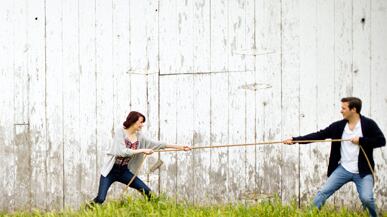Catherine Blyth's last book, The Art of Conversation, was offered as a guide to a lost art, a refresher on the do's and don'ts of courteous communication; the electronic age, she said, had made us forget our manners. Do we need a similar primer for married life? Has modern life made us forget the reason that so many of us march down the aisle?
Blyth’s new book, The Art of Marriage: A Guide to Living Life as Two, doesn’t exactly advertise its necessity. Marriage is “an heirloom,” “a magnificent social fiction,” an “increasingly irrelevant trap,” Blyth writes. She quotes centuries-old opinions of a similar ilk, and fleshes out her argument for the institution’s irrelevance with contemporary anecdote. “When I think of marriage, it is as though my heart were being dragged out of my vitals,” shuddered Queen Elizabeth I. An acquaintance confesses to Blyth, on the eve of his wedding, that he does not believe that lifelong love is likely “because when marriage was invented, you were dead by 30.”

But make no mistake: This is a straw man, duly dismantled over the course of the book, despite Blyth’s periodic protests over the swollen dimensions of our preoccupation with marriage and its attendant costs. “In 2008,” she laments “an average wedding cost about $27,000 raped from a parent’s pension pot, a child’s mortgage deposit, or both.” The “wedding industry” was worth almost $60 billion in the U.S. in a 2006 estimate. In 1990, newlyweds made up about 2 percent of the U.S. population, but they bought more than half of all cutlery. But, she sighs, we’re all spending; if you’d like to add $22.50 to the tab for some pat wisdom, nicely peppered with historical vignette and seasoned with personal experience, she won’t object to you buying her book.
D.H. Lawrence’s wife had a more bemused idea of sex: “When people talk about sex, I don’t know what they mean—as if sex hopped about by itself like a frog, as if it had no relation to the rest of living.”

Despite the irony that Blyth has written about a subject that she seems to think has been overdone in our culture and inflated in our economy, the book is not without its charms. Self-aware of its dispensability, the book assumes a freewheeling approach, skipping between the centuries to paint an ever-evolving portrait of marriage. Blyth writes for an audience curious for the perspective of Queen Victoria and Madonna, Charles Darwin and Rod Stewart, and this high-low mash-up is difficult to resist. Before proposing to his cousin, Darwin lined up the arguments for and against. Pro: “My God, it is intolerable to think of spending ones whole life, like a neuter bee, working, working & nothing after all.” Con: “Loss of Time.—cannot read in the Evenings—fatness & idleness.” Rock star Rod Stewart was less equivocal upon his marriage to model Rachel Hunter: “I’m happy as a dog with two dicks.”
The Art of Marriage is filled with morsels like these, with the more acerbic among them often proving to be the tastiest. “When the celebrated photographer Antony Armstrong-Jones fell out of love with Princess Margaret,” Blyth writes, “he spelled out his feelings by littering their home with lists entitled ‘Things I hate about you.’” Among the missives: “You look like a Jewish manicurist.” The marriage did not last. To open her chapter on the role that children play in marriage, Blyth quotes Napoleon Bonaparte. “I want to marry a womb,” he declared upon ditching his older wife for a younger woman. To preserve marital harmony, the wife of the novelist Georges Simenon accompanied her husband to his favored brothel and helped him choose his girls. D.H. Lawrence’s wife had a more bemused idea of sex: “When people talk about sex, I don’t know what they mean—as if sex hopped about by itself like a frog, as if it had no relation to the rest of living.”
And there are genuinely touching episodes related in The Art of Marriage. When Nathaniel Hawthorne told his wife that he had been fired from his job, she left the room, returned with kindling and made a fire for him; “Next,” writes Hawthorne, “she brings pen, paper, ink, and sets them beside him. Then she touches the sad man on the shoulder, and, as he turns to the beaming face, says, ‘Now you can write your book.’” Mixed in with such wedding-toast fodder are statistics: A 1992 study found that unmarried women were 86 percent poorer and bachelors 61 percent poorer than the married or widowed over the course of their lives. Married individuals have less intense relationships with their parents than people who are divorced or have remained single, according to a 2008 study.
But, ultimately, these vignettes and statistics don’t add up to much, and the book’s stance—between the high and low, vignette and statistic—doesn’t help to clarify the book’s purpose. Is it a historical survey or pop culture commentary? Entertainment or self help? The answer is that it’s a bit of everything, and there’s nothing wrong with that. But, when it veers toward inspirational instruction—as it’s marketed to be—it enters the realm of the painfully obvious. On the unique challenges of marriage: “Every marriage shares one secret,” Blyth writes; “[t]hat it is like no other.” Gee. On adultery: “Sadly, few people approach affairs with clarity.” To further explicate the obvious: “Uncommon”—i.e., adulterous—“arrangements vary hugely.” I should hope so. And, to assuage your raging fears about the little creatures spawned by so many marriages: “There is no such thing as an ideal parent.” Phew.
Even more irksome than the aphorisms is the obviousness of the advice. “If you cannot resist the temptations of infidelity, practice to deceive,” Blyth writes. To assist with money matters: “The solution is to be generous and approach your union as one of financial equals.” A sentiment repeated so often in the book that I can’t even remember the context: “To work, marriage must balance our needs as individual and foster our partnership.” It’s not that this is bad advice, but it’s disappointing that a mind capable of gathering up so many tasty nuggets of other people’s matrimonial wisdom could not come up with a few of her own. Clichéd description is lazy, but clichéd proscription is just annoying. But maybe when it comes to a guide on marriage, that’s the most we can expect.
Plus: Check out Book Beast, for more news on hot titles and authors and excerpts from the latest books.
Chloë Schama is the assistant managing editor of The New Republic and the author of Wild Romance: A Victorian Story of a Marriage, a Trial, and a Self-Made Woman .





